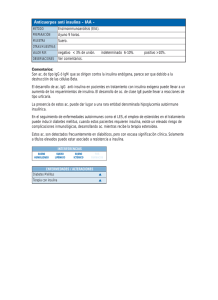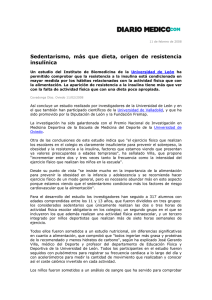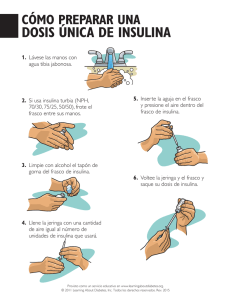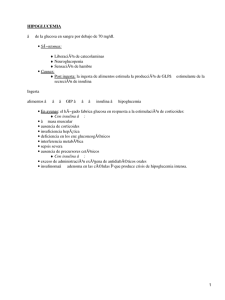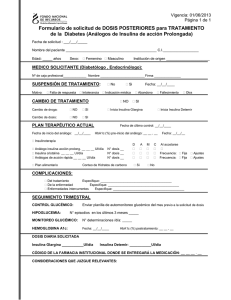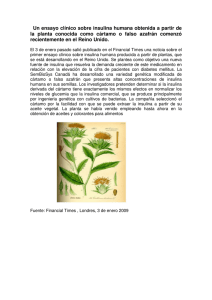Inyecciones de insulina - Health Online
Anuncio
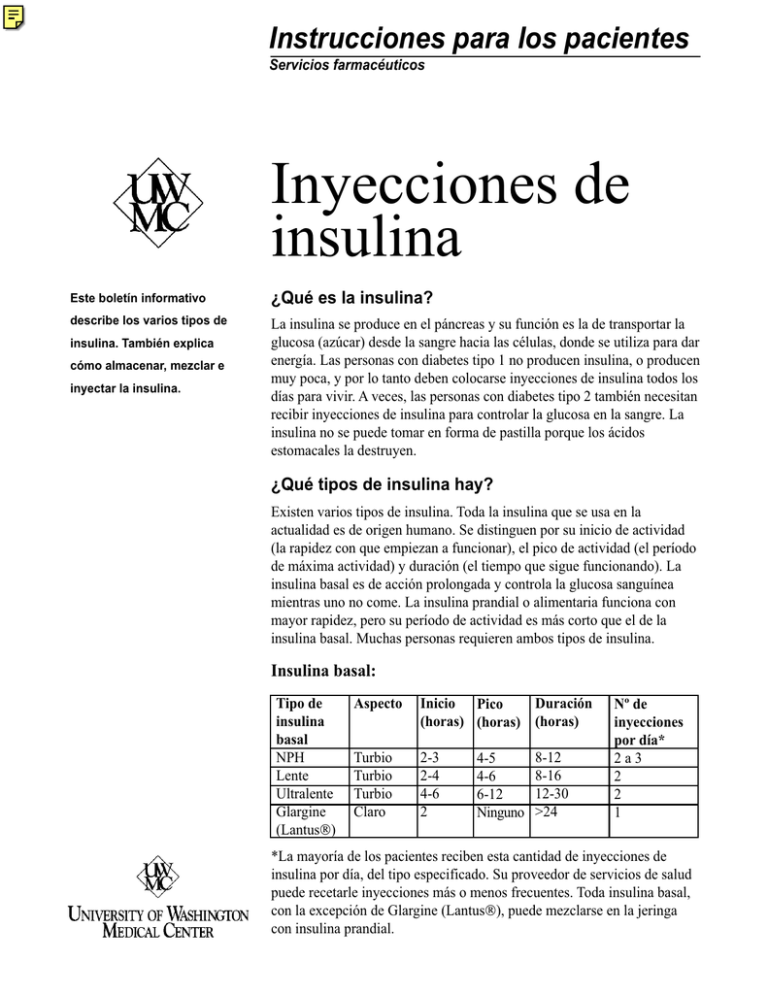
Instrucciones para los pacientes Servicios farmacéuticos Inyecciones de insulina Este boletín informativo ¿Qué es la insulina? describe los varios tipos de La insulina se produce en el páncreas y su función es la de transportar la glucosa (azúcar) desde la sangre hacia las células, donde se utiliza para dar energía. Las personas con diabetes tipo 1 no producen insulina, o producen muy poca, y por lo tanto deben colocarse inyecciones de insulina todos los días para vivir. A veces, las personas con diabetes tipo 2 también necesitan recibir inyecciones de insulina para controlar la glucosa en la sangre. La insulina no se puede tomar en forma de pastilla porque los ácidos estomacales la destruyen. insulina. También explica cómo almacenar, mezclar e inyectar la insulina. ¿Qué tipos de insulina hay? Existen varios tipos de insulina. Toda la insulina que se usa en la actualidad es de origen humano. Se distinguen por su inicio de actividad (la rapidez con que empiezan a funcionar), el pico de actividad (el período de máxima actividad) y duración (el tiempo que sigue funcionando). La insulina basal es de acción prolongada y controla la glucosa sanguínea mientras uno no come. La insulina prandial o alimentaria funciona con mayor rapidez, pero su período de actividad es más corto que el de la insulina basal. Muchas personas requieren ambos tipos de insulina. Insulina basal: Tipo de insulina basal NPH Lente Ultralente Glargine (Lantus) Aspecto Inicio Pico Duración (horas) (horas) (horas) Turbio Turbio Turbio Claro 2-3 2-4 4-6 2 4-5 4-6 6-12 Ninguno 8-12 8-16 12-30 >24 Nº de inyecciones por día* 2a3 2 2 1 *La mayoría de los pacientes reciben esta cantidad de inyecciones de insulina por día, del tipo especificado. Su proveedor de servicios de salud puede recetarle inyecciones más o menos frecuentes. Toda insulina basal, con la excepción de Glargine (Lantus), puede mezclarse en la jeringa con insulina prandial. Página 2 Servicios farmacéuticos Inyecciones de insulina Insulina prandial: Tipo de insulina prandial Inicio (min.) Regular 30-60 Lispro <15 (Humalog) Aspart <15 (Novolog) Pico (horas) Duración (horas) Nº de inyecciones por día* 2-3 1-1.5 6-8 4 2-3 3-4 1-1.5 <5 3-4 La insulina prandial debe inyectarse antes de las comidas para que pueda funcionar mientras el paciente come. El inicio de actividad de su insulina prandial determina con cuánto tiempo de anticipación debe ponerse la inyección antes de comer. Para detalles adicionales consulte con su asesor de diabetes. ¿Cómo debo almacenar la insulina? La insulina sin abrir debe guardarse en el refrigerador (no debe congelarse) y puede usarse hasta la fecha de vencimiento indicada en la botella. Las botellas de insulina abiertas pueden guardarse a temperatura ambiente (menos de 85oF) durante 30 días. Cada vez que use insulina debe inspeccionar para asegurarse de que la insulina clara esté todavía clara y que la insulina turbia esté uniformemente turbia. Si la insulina tiene “grumos”, o si debe ser clara pero parece turbia, debe desecharla y obtener una botella nueva. Mantenga siempre disponible una botella extra de cada tipo de insulina en caso de emergencias. Cómo colocar una inyección de insulina ¿Qué tipos de jeringas para insulina hay? Las jeringas para insulina vienen en 3 tamaños. Usted utilizará una jeringa de 3/10 cc (30 unidades), de 1/2 cc (50 unidades) o de 1cc (100 unidades), según la cantidad de insulina que deba tomar por inyección. Las jeringas para insulina vienen con la aguja ya instalada. Al diámetro o grosor de la aguja se le denomina “calibre”. Cuanto más fina sea la aguja, mayor será su calibre. Las agujas pueden ser de longitud estándar o más cortas. Las agujas cortas las deben usar solamente los niños y los adultos muy delgados. Las jeringas y agujas para insulina deben utilizarse solamente una vez ya que las agujas son muy finas y pueden dañarse con el uso repetido. Las jeringas y agujas para insulina deben desecharse en un recipiente “sharps” apropiado. Para información adicional acerca de los recipientes, consulte con su asesor de diabetes. Página 3 Servicios farmacéuticos Inyecciones de insulina ¿Dónde debo inyectarme la insulina? La insulina se inyecta en los tejidos subcutáneos (la capa de grasa que se encuentra debajo de la piel) en las áreas del estómago, el exterior de la parte superior del brazo, la parte delantera o los lados de los muslos, los glúteos (nalgas) o las caderas. ¿Cómo hago para llenar de insulina la jeringa? 1. Reúna los materiales (insulina, jeringa y gasas con alcohol). 2. Lávese las manos con jabón y agua y séquelas bien. 3. Si utiliza la insulina turbia, asegúrese de que esté uniformemente turbia (bien mezclada), haciendo dar vueltas a la botella entre las palmas de las manos, pero teniendo cuidado de no agitar la botella de insulina. 4. Si la botella es nueva, quite la tapa de plástico de color. Tanto para las botellas nuevas como para las que han sido abiertas, limpie el tapón de caucho en la parte superior usando una gasa con alcohol. 5. Quite la tapa de la aguja y retire el émbolo de le jeringa hasta que marque el número de unidades que va a usar. 6. Con el frasco de insulina sobre una mesa, inserte la aguja directamente hacia abajo, perforando el tapón de caucho. Presione el émbolo hacia abajo para inyectar todo el aire dentro del frasco. 7. Sin retirar la jeringa del frasco, invierta el frasco y la jeringa. Retirando el émbolo, permita que la jeringa se llene con insulina yendo más allá de su dosis. 8. Empuje lentamente el émbolo hasta llegar a la línea que marca su dosis. 9. Mire para ver si han quedado burbujas de aire en la jeringa. Si es así, inyecte la insulina de vuelta en el frasco y repita los pasos 7 y 8. 10. Retire la aguja del frasco y colóquese la inyección de la manera que le ha enseñado su asesor de diabetes. Página 4 Servicios farmacéuticos Inyecciones de insulina ¿Cuál es el método para mezclar más de un tipo de insulina en la jeringa? Advertencia: La insulina Glargine (Lantus®) no puede mezclarse con ninguna otra insulina. 1. Reúna los materiales (insulina, jeringa y gasas con alcohol). 2. Lávese las manos con jabón y agua y séquelas bien. 3. Asegúrese de las dosis de cada tipo de insulina que se va a inyectar. Unidades de la primera insulina (Lispro, Aspart, Regular) + Unidades de la segunda insulina (NPH, Lente, Ultralente) Advertencia: La insulina Glargine no puede mezclarse con ninguna otra insulina = Total de unidades de insulina 4. Si utiliza la insulina turbia, asegúrese de que esté uniformemente turbia (bien mezclada), haciendo dar vueltas a la botella entre las palmas de las manos, pero teniendo cuidado de no agitar la botella de insulina. 5. Si la botella es nueva, quite la tapa de plástico de color. Tanto para las botellas nuevas como para las que han sido abiertas, limpie el tapón de caucho en la parte superior usando una gasa con alcohol. 6. Quite la tapa de la aguja y retire el émbolo de le jeringa hasta que marque el número de unidades de la 1ª insulina que va a usar. Con la botella recta sobre la mesa, inyecte el aire dentro de la botella de insulina. Repita el proceso para la 2ª insulina. No deje que la aguja toque la primera insulina dentro de la botella. 7. Retire la aguja de la 2ª botella de insulina, luego insértela en la 1ª botella de insulina. Invierta la botella y la jeringa, luego retire el émbolo hacia abajo hasta que haya sacado el número de unidades que necesitará. Saque la aguja directamente de la botella. 8. Inserte la aguja en la botella del 2° tipo de insulina y retire el émbolo hasta que haya sacado la cantidad total de unidades que necesita de ambos tipos de insulina. 9. Retire la aguja y colóquese la inyección de la forma que le ha enseñado su asesor de diabetes. Página 5 Servicios farmacéuticos Inyecciones de insulina Al mezclar la insulina, siempre comience con la de inicio de actividad más rápido y termine con la de inicio más lento Lispro/Aspart ➝ Regular ➝ NPH/Lente ➝ Ultralente ¿Cómo se inyecta la insulina? • Elija el sitio de inyección. • Entre sus dedos índice y pulgar, tome un pliegue de piel y del tejido graso subcutáneo. • Inserte la aguja en el pliegue de tejido, en ángulo recto (90o). • Inserte toda la aguja. • Suelte el pliegue de tejido. • Inyecte la insulina, empujando el émbolo en forma lenta y constante. • Cuente lentamente hasta 5 y luego retire la aguja. Esto evitará que la insulina se escape del sitio de inyección. • Deseche las agujas y jeringas usadas en un recipiente “sharps”. Sugerencias para reducir el dolor al inyectarse • Inyecte la insulina a temperatura ambiente. • Quite todas las burbujas de aire de la jeringa antes de colocarse la inyección. • Evite cambiar la orientación de la aguja mientras la inserta o retira. • No utilice las agujas más de una vez. • No se apriete la piel con demasiada fuerza. Página 6 Servicios farmacéuticos Inyecciones de insulina Notas ¿Preguntas? Sus preguntas son importantes. Si tiene preguntas o inquietudes, consulte con su médico u otro proveedor de servicios de salud. El personal de la clínica UWMC también se encuentra a su disposición para ayudarle en cualquier momento. Nombre de su proveedor: ____________________ Número de teléfono de su proveedor: ____________________ ____________________ Pharmacy Services Box 356015 1959 NE Pacific St. Seattle, WA 98195 206-598-4999 120440 © University of Washington Medical Center Pharmacy Services Insulin Injections Spanish 10/2002 Patient Education Pharmacy Services This handout details the What is insulin? types of insulin. It also Insulin is made by the pancreas and acts as a key to move glucose (sugar) from the blood into cells where it is used for energy. People with Type 1 diabetes make little or no insulin, and thus must give insulin injections (shots) every day to survive. Sometimes people with Type 2 diabetes also need to take insulin injections to control their blood glucose. Insulin cannot be taken as a pill because the acids in the stomach would destroy it. covers how to store, mix and inject insulin. What types of insulin are there? There are several types of insulin. All insulin used today is human insulin. They differ in onset (how soon they start to work), peak (maximum effect) and duration (how long they last). Basal insulin is long acting and controls blood glucose when you are not eating. Prandial or food insulin works more quickly, but does not last as long as basal insulin. Many people need both a basal and a prandial insulin. Basal Insulin: Type of Basal Insulin NPH Lente Ultralente Glargine (Lantus) How it looks Onset (hrs.) Peak (hrs.) Duration (hrs.) # Injections per day* Cloudy Cloudy Cloudy Clear 2-3 2-4 4-6 2 4-5 4-6 6-12 None 8-12 8-16 12-30 >24 2 to 3 2 2 1 *Most patients take this number of injections per day of that type of insulin. Your provider may have you give your basal insulin more or less often. All basal insulin except Glargine (Lantus) can be mixed in a syringe with prandial insulin. Page 2 Pharmacy Services Insulin Injections Prandial Insulin: Type of Prandial Insulin Onset (min.) Peak (hrs.) Duration (hrs.) # Injections per day Regular 30-60 Lispro <15 (Humalog) Aspart <15 (Novolog) 2-3 1-1.5 6-8 4 2-3 3-4 1-1.5 <5 3-4 Prandial insulin must be injected before eating so that it is ready to do its job when you eat. The onset of your prandial insulin will determine how soon before you eat you should inject your insulin. Ask your diabetes educator for details. How do I store insulin? Unopened insulin should be kept in the refrigerator, (do not freeze) and is good until the expiration date marked on the bottle. Open bottles of insulin can be stored at room temperature (<85oF) for 30 days. Each time you use your insulin you should inspect it to make sure that clear insulin remains clear, and that cloudy insulin is uniformly cloudy. If your insulin has clumps or is supposed to be clear and appears cloudy, you should throw it away and get a fresh bottle. Always keep a spare bottle of each kind of insulin on hand for emergencies. Giving an Insulin Injection What types of insulin syringes are there? Insulin syringes come in 3 sizes. You will use 3/10 cc (holds 30 units), ½ cc (holds 50 units) or 1cc (holds 100 units) depending on how much insulin you take per injection. Insulin syringes come with needles attached. The diameter or thickness of the needle is called its gauge. The smaller the diameter of the needle, the larger the gauge of the needle. Needles come in short or standard length. Short needles should only be used for children or very thin adults. Insulin syringes and needles should be used only once. The needles are very thin and can be damaged with repeated use. Insulin syringes and needles must be discarded in an appropriate “sharps” container. Ask your diabetes educator for advice about containers. Page 3 Pharmacy Services Insulin Injections Where do I inject insulin? Insulin is injected into the subcutaneous tissue (fat layer just under the skin) in the stomach, outside of the upper arm, front/sides of the thighs, buttocks, or hip areas. Your diabetes educator will teach you the correct way to give an insulin injection. How do I draw up the insulin into a syringe? 1. Gather your supplies (insulin, syringe, alcohol pads). 2. Wash your hands with soap and water. Dry your hands well. 3. If using cloudy insulin, make sure it is uniformly cloudy (mixed) by rubbing the bottle between the palms of your hands and by turning it end to end. Do not shake insulin. 4. If using a new bottle, remove the colored plastic cap. For both new and previously opened bottles, clean the rubber stopper on the top with an alcohol pad. 5. Remove the cap from the needle and pull the plunger on the syringe back to the number of units you will be using. 6. With the insulin vial on a table put the needle straight into the rubber stopper. Push the plunger down to inject air into the vial. 7. With the needle still in the vial, turn the vial and syringe upside down. Pull the plunger to fill the syringe past your dose of insulin. 8. Slowly push the plunger back to your dose of insulin. 9. Check for air bubbles. If bubbles are present, inject the insulin back into the vial and repeat steps 7 & 8. 10. Remove the needle from the bottle and inject as told by your diabetes educator. Page 4 Pharmacy Services Insulin Injections How do I mix more than one type of insulin in a syringe? Warning: Glargine (Lantus®) Insulin cannot be mixed with any other insulin. 1. Gather your supplies (insulin, syringe, alcohol pads). 2. Wash your hands with soap and water. Dry your hands well. 3. Know your dose for each type of insulin you will be injecting. Units of 1st Insulin (Lispro, Aspart, Regular) + Units of 2nd Insulin (NPH, Lente, Ultralente) Warning: Insulin Glargine cannot be mixed with any other insulin = Total units of insulin 4. If using cloudy insulin make sure it is uniformly cloudy (mixed) by rubbing the between the palms of your hands and by turning it end to end. Do not shake insulin. 5. If using a new bottle, remove the colored plastic cap. For both new and previously opened bottles, clean the rubber stopper on the top with an alcohol pad. 6. Remove the cap from the needle and pull plunger back to the number of units of 1st insulin you will be using. Inject this into the insulin bottle with the bottle upright on a table. Repeat process for the 2nd insulin. Do not touch needle to the insulin in the bottle. 7. Remove the needle from the 2nd insulin bottle. Insert the needle into the 1st insulin bottle. Tip the bottle and syringe upside down, and draw the plunger down to the number of units you will need. Pull the needle straight out of the bottle. 8. Insert the needle into the 2nd type of insulin and draw the plunger to the total number of units you will need of both types of insulin. 9. Remove the needle and inject as told by your diabetes educator. Page 5 Pharmacy Services Insulin Injections When Mixing Insulin Always Go from Fastest Onset to Slowest Lispro/Aspart Regular NPH/Lente Ultralente How do I inject insulin? • Choose your injection site. • Pinch the skin and fat tissue between your thumb and first finger. • Put the needle into the pinched tissue at a 90o angle. Push the needle all the way in. • Let go of the pinched tissue. • Inject the insulin by using a slow and steady push on the plunger. • Count slowly to 5 and then remove the needle. This will prevent insulin from leaking out of the injection site. • Dispose of your used needles and syringes in a sharps container. Tips To Help Lessen Injection Pain • Inject insulin at room temperature. • Remove all air bubbles from the syringe before injection. • Avoid changing the direction of the needle during insertion or removal. • Do not reuse needles. • Do not pinch too tightly. Page 4 Pharmacy Services Insulin Injections Notes Questions ? Your questions are important. Call your doctor or health care provider if you have questions or concerns. UWMC Clinic staff are also available to help at any time. ________________________________________________________ ________________________________________________________ ________________________________________________________ ________________________________________________________ ________________________________________________________ Your Provider’s Name: ___________________ Your Provider’s Phone Number: ___________________ ___________________ Pharmacy Services Box 356015 1959 N.E. Pacific St. Seattle, WA 98195 206-598-4999 © University of Washington Medical Center 10/2002

